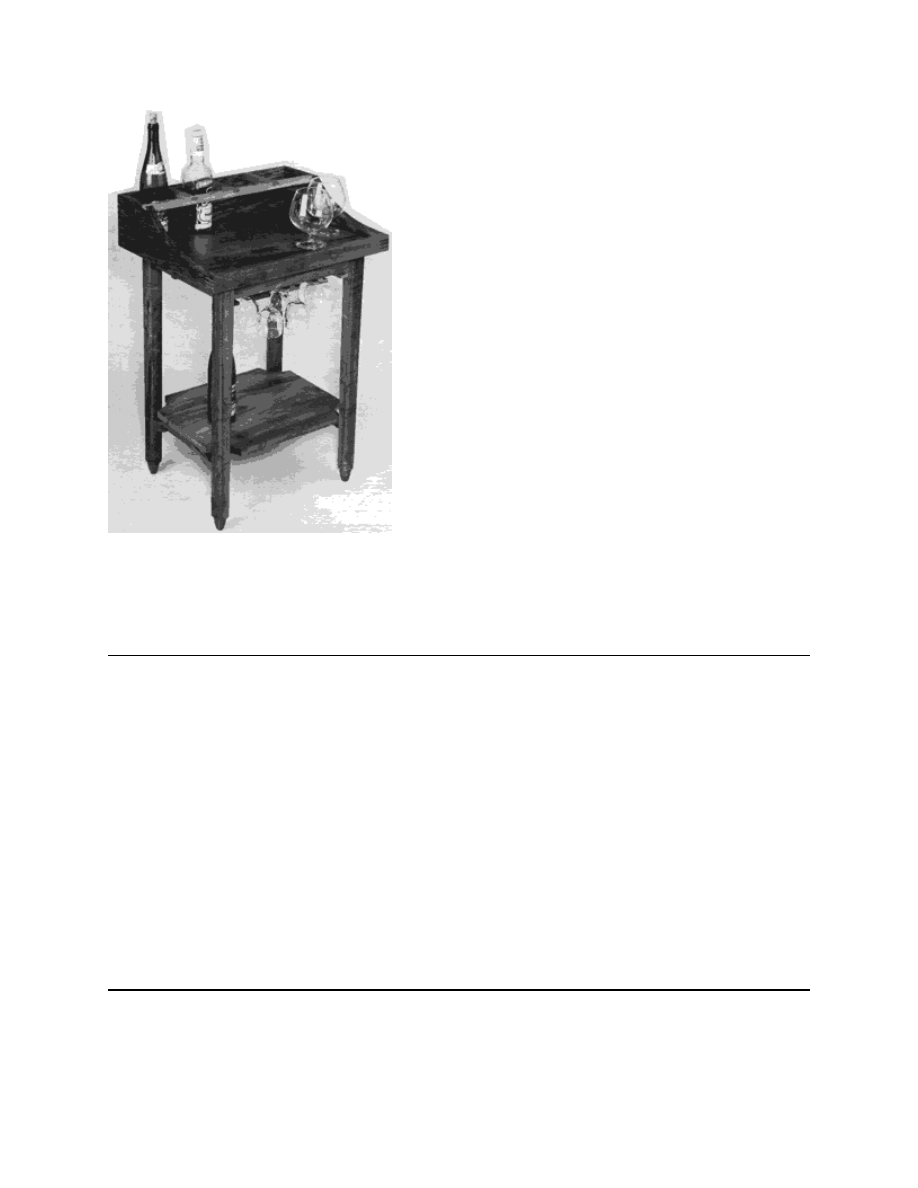
Project 17824EZ:
Dry Bar
A small bar like this is ideal in a room where
space is at a premium. It holds several bottles
on top, while stemware stores nicely hung
upside down on the underside. Ours was
made from Imbuyam — sometimes called
Brazilian Walnut — a wood that ranges in
color from yellowish to chocolate brown. The
stock we had was beautifully figured, and
looks very striking in the finished state. Of
course, there’s no hard and fast rule that
dictates what wood is best for a particular
project. That choice is yours.
Dry Bar Materials List
Part
Description
Size
No. Req’d
A
Leg
1-5/8" x 1-5/8" x 24-3/4"
4
B
Side Apron
3/4" x 2-1/4" x 13-3/4"
2
C
Front and Back Apron
3/4" x 2-1/4" x 17-1/4"
2
D
Side Stretcher
3/4" x 2" x 13-3/4" (incl. tenons)
2
E
Cross Stretcher
3/4" x 1" x 17-1/8" (incl. tenons)
2
F
Back Cleat
3/4" x 1-3/4" x 17-1/8" (incl. tenons)
1
G
Outside Glass Holder
1" x 1-1/2" x 9-1/4"
2
H
Inside Glass Holder
1-1/2" x 1-7/8" x 9-1/4"
3
I
Pin
1/2" dia. x 2" long
2
J
Shelf
3/4" x 14-1/2" x 18"
1
K
Upper Back
3/4" x 5-5/8" x 22-1/2"
1
L
Upper End
3/4" x 5-5/8" x 17-1/2"
2
M
Upper Front
3/4" x 1-3/4" x 22-1/2"
1
N
Bottom
3/4" x 16-5/8" x 21-5/8"
1
O
Side Bottle Support
3/4" x 3/4" x 6"
3
P
End Bottle Support
3/4" x 3/4" x 22-1/2"
1
Q
Foot
1-1/4" dia. x 1-5/8" long
4
R
Pin
1/2" dia. x 1-7/16" long
4
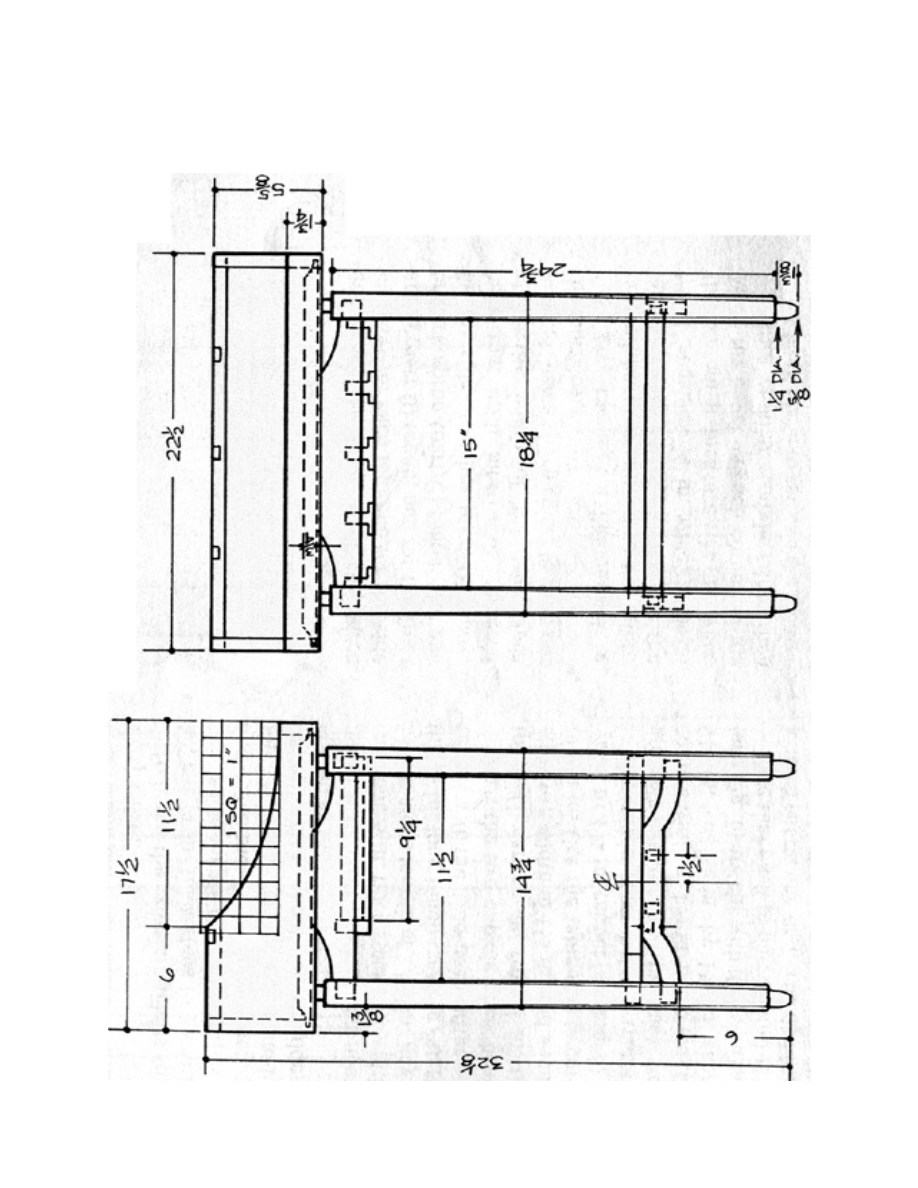
Dry Bar Complete Schematic
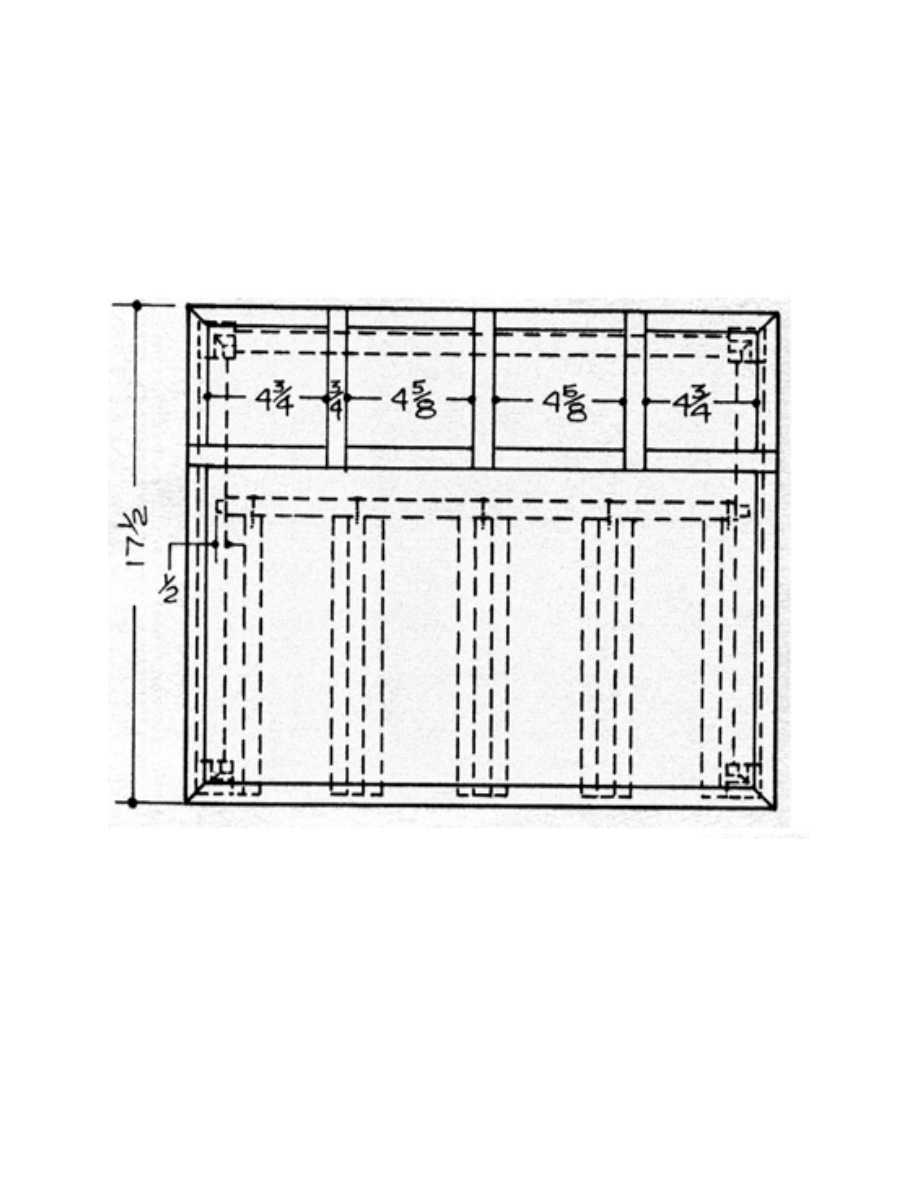
Top Detail
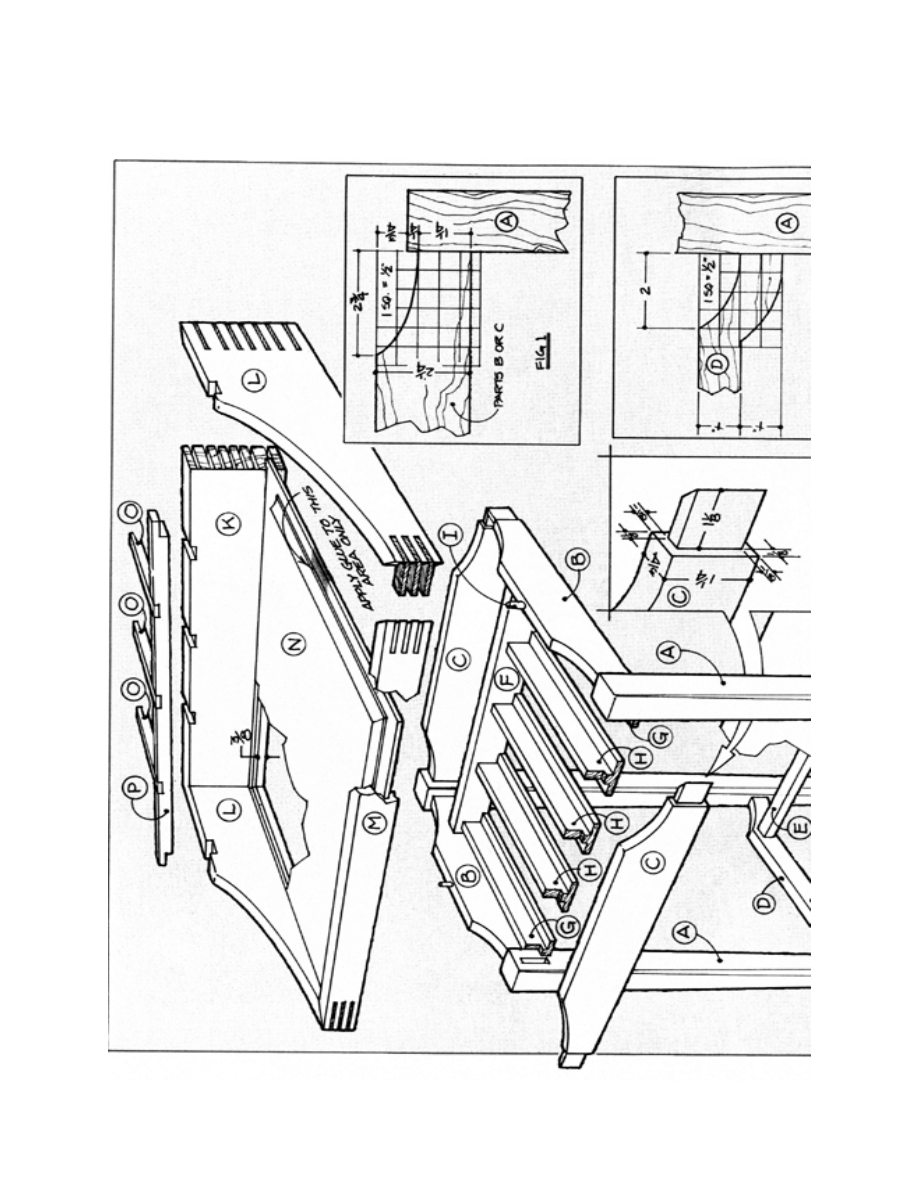
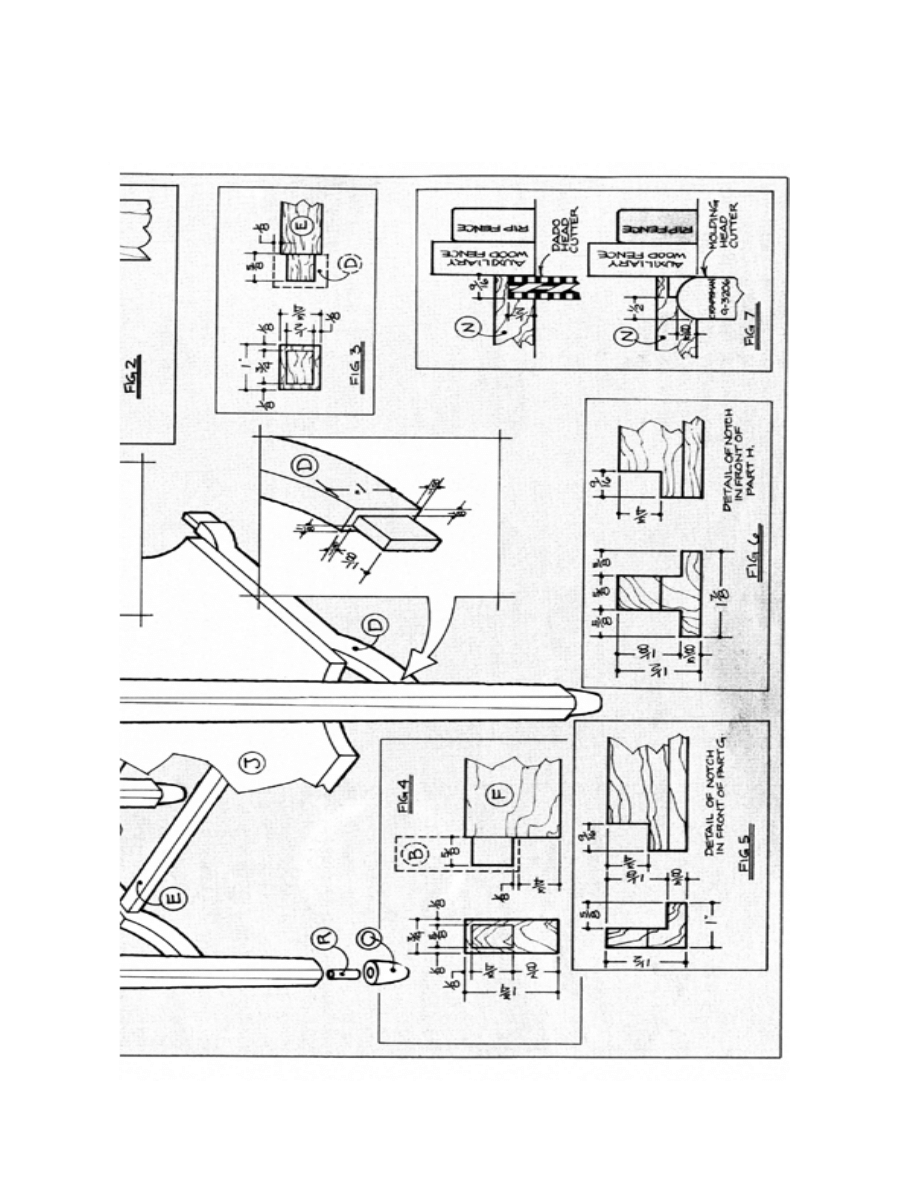
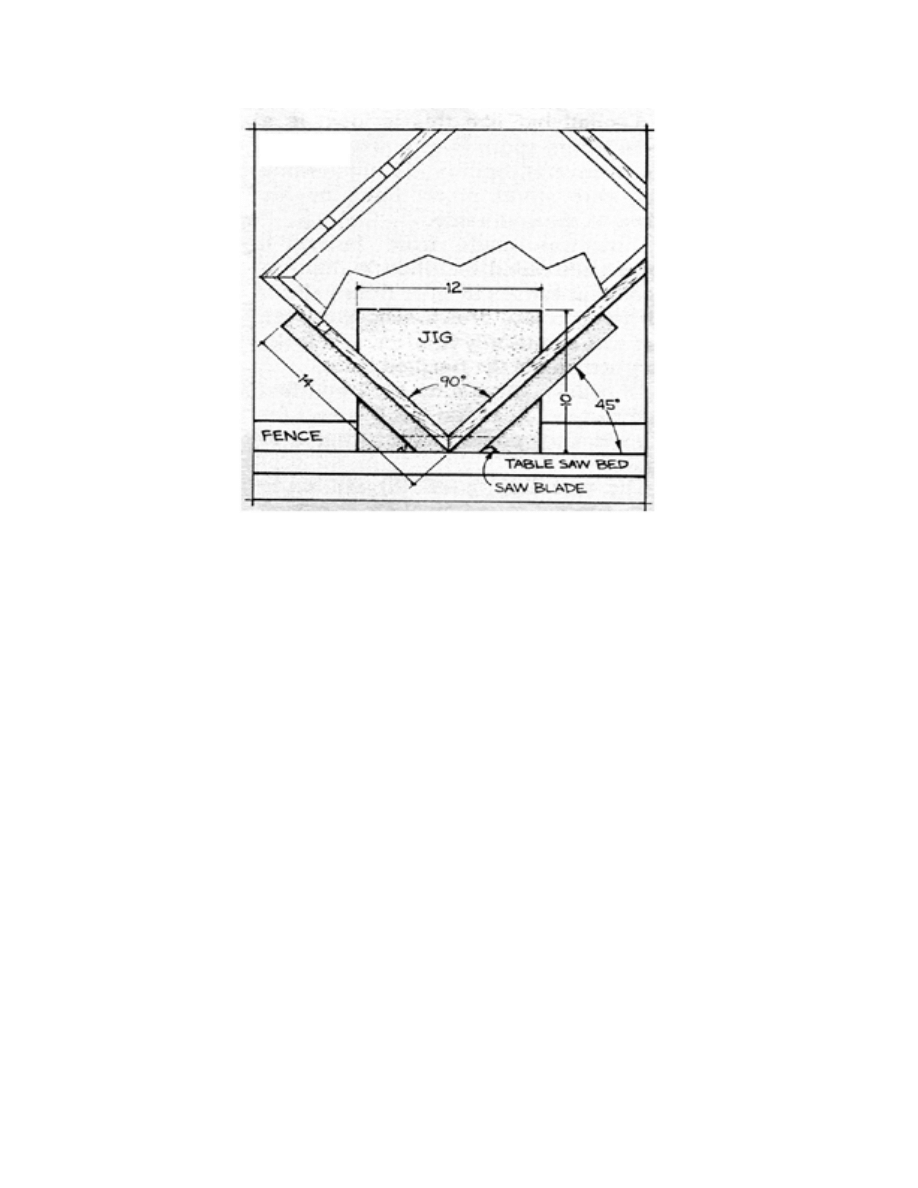
Dry Bar Step-by-Step Instructions
1. Select a piece of 2" nominal stock (1-3/4" actual) from which to make the
four legs (A).
2. Cut each leg to 1-5/8" square by 24-3/4" long.
3. Lay out and mark the location of the three mortises for each leg: one for the
side apron (B) tenon, one for the front or back apron (C) tenon, and one for
the side stretcher (D) tenon. NOTE: Each mortise is centered along the
width of the leg.
4. Use a sharp chisel to chop out the mortises.
5. Use a yardstick or long straight edge to mark a tapered bevel (1/8" wide at
the top; 5/8" wide at the bottom) on the entire length of each corner.
6. Use a hand plane to remove the bevel stock.
7. Select a piece of 3/4" stock from which to make the two side aprons (B) and
the front and back aprons (C). NOTE: Except for length, both pieces are
identical (see Figure 1).
8. Cut each piece to 2-1/4" wide and to the correct length shown in the bill of
materials.
9. Equip the table saw with a dadohead cutter.
10. Mark the 1-1/8" tenon length on each end of the aprons.
11. Adjust the dado-head to make a 1/8" deep cut.
12. Hold the stock against the miter gauge, face side down.
FIG 8

13. Run the stock through the cutter to establish the 1-1/8" length.
14. Make additional passes to clean up the waste stock.
15. Repeat this process for the other face side and also the bottom edge.
16. Adjust the dado head to make the 1-1/8" deep top edge cut.
17. Set the regular saw blade at 45 degrees, and cut the bevel on each tenon
Transfer the curved profile (shown in Figure 1) from the grid pattern to the
stock.
18. Cut out the profile with a band or saber saw.
19. Lay out and mark the location on Part B of the mortise for the back cleat (F)
(see Figure 4).
20. Cut 3/4" thick stock to a width of 2" and a length of 13-3/4" to make the
two side stretchers (D) (see Figure 2).
21. Mark the 1-1/8" tenon length on each end.
22. Adjust the dadohead to make a 1/8" deep cut.
23. Cut each tenon following the same procedure that was used to make parts B
and C.
24. Cut the curved profile in the same manner.
25. Lay out and mark the location of the mortises for the two cross-stretchers
(E).
26. Use a sharp chisel to chop out the mortises.
27. Cut 3/4" thick stock to a width of 1" and a length of 17-1/8" to make the
cross-stretchers (E).
28. Lay out and mark the 5/8" long tenon (see Figure 3)
29. Set up the dado-head cutter to make the 1/8" shoulder all around as shown.
30. Cut the back cleat (F) from 3/4" thick stock to a width of 1-3/4" and a
length of 17-1/8".
31. Lay out the 5/8" long tenon (see Figure 4).
32. Cut out the tenon with the dado-head cutter.
33. Cut the two outside glass holders (G) from 1" thick stock to a width of 1-1/
2" and a length of 9-1/4".
34. Use the table saw to cut the 5/8" by 1-1/8" rabbet (see Figure 5).
35. Cut the inside glass holders (H) from 1-1/2" thick stock to a width of 1-7/8"
and a length of 9-1/4".
36. Use the table saw to cut the 5/8" by 1-1/8" rabbets (see Figure 6).
37. Use the dado-head cutter, set to a height of 3/4", to cut the notches on one
end of both part G and H.
38. Edge-glue and clamp two or more narrower boards to get the 14-1/2" width
necessary to make the long shelf (J).
39. Allow the glue to dry.

40. Trim the shelf to the final dimensions (14-1/2" wide x 18" long).
41. Scribe the 5-1/2" radius at each corner.
42. Use the band or saber saw to cut out the radius.
43. Select a piece of 1-1/2" square stock to make the four feet (Q).
44. Lathe-turn each foot to 1-3/8" long, noting that the foot tapers from 1-1/2"
diameter at the top to 5/8" diameter at the bottom.
45. Sand each foot smooth.
46. Drill a 1/2" diameter by 3/4" deep hole at the center of each foot as shown.
47. Drill a matching hole in the bottom of each leg (A).
48. Use 1/2" diameter by 1-7/16" long dowel pins, glue, and clamps to join
parts A to Q.
49. Select a piece of 3/4" thick stock measuring 5-5/8" wide to make the upper
back (part K), the two upper ends (parts L), and the upper front (part M) can
be cut.
50. Cut each part to approximately 1" longer than the length shown in the mate-
rials list.
51. Miter each end to 45 degrees while cutting the parts to final length.
52. Cut, at a point 3/8" from the bottom edge of the stock, a 3/8" deep by 1/4"
wide groove on the inside of each piece to accept the bottom (part N).
53. Use the dadohead cutter to cut the 5/16" deep by 3/4" wide notches on the
top edge of both parts K and L.
54. Transfer the grid pattern for part L from the drawing to the stock.
55. Use a band or saber saw to cut to shape.
56. Edge-glue 3/4" stock for the top (part N), allowing extra for both length and
width.
57. Allow to dry.
58. Cut to length and width.
59. Use a dado-head cutter, a molding-head cutter, and an auxiliary wood fence
to cut the edging for the top (see Figure 7).
60. Apply glue to the miters on parts K, L, M, and N.
61. Apply glue to a 2" wide strip along the edge of the bottom (see exploded
drawing.
62. Assemble parts K, L, M, and N.
63. Use web clamps to clamp the miters together.
64. Cut a piece of cut a piece of 3/4" particleboard to 10" by 12" to begin mak-
ing the table saw jig needed to cut the splines (see Figure 8).
65. Cut two pieces of 3/4" stock to 1-1/2" wide by 14" long.
66. Miter one end of each piece.

67. Glue the mitered pieces to the particleboard as shown.
68. Set the table saw fence to a height of 7/8".
69. Position the jig against the rip fence.
70. Locate the fence to make the first miter cut.
71. Pass the stock through the blade.
72. Cut splines to fit the grooves.
73. Glue in place.
74. Allow the glue to dry.
75. Hand plane the excess spline.
76. Sand flush.
77. Cut parts O and P and half-lap them at each end.
78. Sand all parts thoroughly, finishing with 220-grit sandpaper.
79. Assemble as shown. NOTE: Parts G and H are joined to part F with a
single wood screw in each joint, while a pair of wood screws through
each part D joins part J.
80. Use a dowel pin (I) to join the top unit (parts K, L, M, and N) to part B.
81. Final sand.
82. Apply two coats of Watco Danish Oil to complete the project.
These plans were originally published in Volume 8, Issue 2 of The Woodworker’s
Journal (Mar./Apr. 1984, pages 35-37).
Wyszukiwarka
Podobne podstrony:
Dry Bar (1)
Cabinets Bar Plans
Dry Bar (2)
2 Woodworking Plans Standing Router Table
Router Table Fence Plans
Ottoman Coffe Table & Ottoman Plans
(Ebooks) DIY Woodwork Plans Drill Press Table
Router table plans
bar psi table
2 Woodworking Plans TableChair Harvest Table
bar psi table convert
Woodwork Plans Simple Garden Workbench Or Table
Woodwork Plans Outdoor Table And Bench
oak dining table
Coffee Table 1
table style2, ♥Dokumenty
table cellspacin5, ❀KODY RAMEK I INNE, Ramki
table border (2)
więcej podobnych podstron